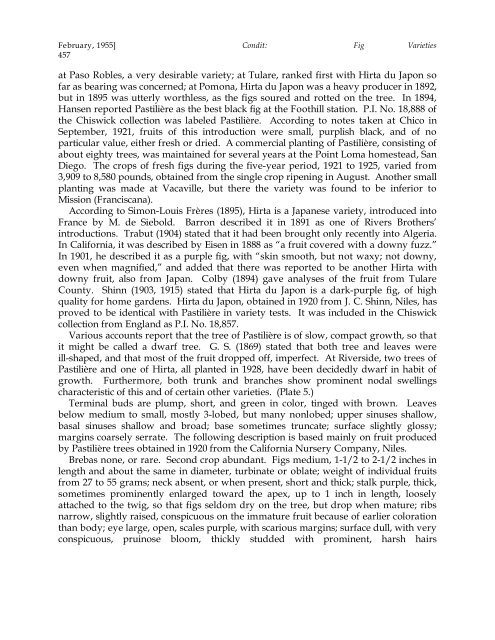Fig Varieties: A Monograph - uri=ucce.ucdavis
Fig Varieties: A Monograph - uri=ucce.ucdavis
Fig Varieties: A Monograph - uri=ucce.ucdavis
You also want an ePaper? Increase the reach of your titles
YUMPU automatically turns print PDFs into web optimized ePapers that Google loves.
February, 1955] Condit: <strong>Fig</strong> <strong>Varieties</strong><br />
457<br />
at Paso Robles, a very desirable variety; at Tulare, ranked first with Hirta du Japon so<br />
far as bearing was concerned; at Pomona, Hirta du Japon was a heavy producer in 1892,<br />
but in 1895 was utterly worthless, as the figs soured and rotted on the tree. In 1894,<br />
Hansen reported Pastilière as the best black fig at the Foothill station. P.I. No. 18,888 of<br />
the Chiswick collection was labeled Pastilière. According to notes taken at Chico in<br />
September, 1921, fruits of this introduction were small, purplish black, and of no<br />
particular value, either fresh or dried. A commercial planting of Pastilière, consisting of<br />
about eighty trees, was maintained for several years at the Point Loma homestead, San<br />
Diego. The crops of fresh figs during the five-year period, 1921 to 1925, varied from<br />
3,909 to 8,580 pounds, obtained from the single crop ripening in August. Another small<br />
planting was made at Vacaville, but there the variety was found to be inferior to<br />
Mission (Franciscana).<br />
According to Simon-Louis Frères (1895), Hirta is a Japanese variety, introduced into<br />
France by M. de Siebold. Barron described it in 1891 as one of Rivers Brothers’<br />
introductions. Trabut (1904) stated that it had been brought only recently into Algeria.<br />
In California, it was described by Eisen in 1888 as “a fruit covered with a downy fuzz.”<br />
In 1901, he described it as a purple fig, with “skin smooth, but not waxy; not downy,<br />
even when magnified,” and added that there was reported to be another Hirta with<br />
downy fruit, also from Japan. Colby (1894) gave analyses of the fruit from Tulare<br />
County. Shinn (1903, 1915) stated that Hirta du Japon is a dark-purple fig, of high<br />
quality for home gardens. Hirta du Japon, obtained in 1920 from J. C. Shinn, Niles, has<br />
proved to be identical with Pastilière in variety tests. It was included in the Chiswick<br />
collection from England as P.I. No. 18,857.<br />
Various accounts report that the tree of Pastilière is of slow, compact growth, so that<br />
it might be called a dwarf tree. G. S. (1869) stated that both tree and leaves were<br />
ill-shaped, and that most of the fruit dropped off, imperfect. At Riverside, two trees of<br />
Pastilière and one of Hirta, all planted in 1928, have been decidedly dwarf in habit of<br />
growth. Furthermore, both trunk and branches show prominent nodal swellings<br />
characteristic of this and of certain other varieties. (Plate 5.)<br />
Terminal buds are plump, short, and green in color, tinged with brown. Leaves<br />
below medium to small, mostly 3-lobed, but many nonlobed; upper sinuses shallow,<br />
basal sinuses shallow and broad; base sometimes truncate; surface slightly glossy;<br />
margins coarsely serrate. The following description is based mainly on fruit produced<br />
by Pastilière trees obtained in 1920 from the California Nursery Company, Niles.<br />
Brebas none, or rare. Second crop abundant. <strong>Fig</strong>s medium, 1-1/2 to 2-1/2 inches in<br />
length and about the same in diameter, turbinate or oblate; weight of individual fruits<br />
from 27 to 55 grams; neck absent, or when present, short and thick; stalk purple, thick,<br />
sometimes prominently enlarged toward the apex, up to 1 inch in length, loosely<br />
attached to the twig, so that figs seldom dry on the tree, but drop when mature; ribs<br />
narrow, slightly raised, conspicuous on the immature fruit because of earlier coloration<br />
than body; eye large, open, scales purple, with scarious margins; surface dull, with very<br />
conspicuous, pruinose bloom, thickly studded with prominent, harsh hairs
















![Fig Trees in North Carolina [Archive] - IDigMyGarden ... - Figs 4 Fun](https://img.yumpu.com/26905320/1/190x245/fig-trees-in-north-carolina-archive-idigmygarden-figs-4-fun.jpg?quality=85)